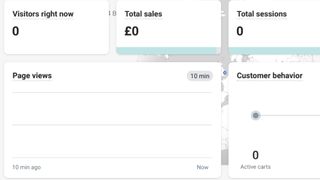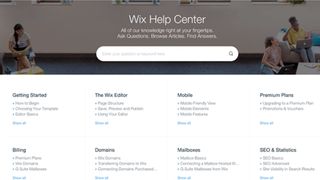[ad_1]
In this Wix vs Shopify article, we’ll dive into both ecommerce options. Many e-commerce website builders offer customizable web templates for your virtual store, content management systems (or CMS), and e-commerce integrations, such as payment processing, that allow transactions to take place. safely.
Between Wix and Shopify, Wix is the benchmark if content and design are essential for your website, while Shopify is stronger in e-commerce functionality. There are, however, more subtle differences that distinguish the two platforms between storefronts, product management, and analytics.
In this article, we pit Wix against Shopify, taking a close look at their top features and performance, along with their pricing and support, so you can find the right platform for your business. Be sure to also check out our article on the best website builders.
02. HostGator: easy to use and great value
Need to get a basic website online, fast? Hostgator is a great affordable choice. Offering a drag-and-drop editor and a choice of 150 templates, it’s easy to set up – no coding or technical knowledge required.
03. Squarespace: the best option for professionals
Squarespace emphasizes beautifully designed templates that make your portfolio look great, making it ideal for creative professionals. Plus, it’s easy to use, there are some great SEO tools, and you can add an online store as well.
01. Wix vs Shopify: features
Here, we compare the eCommerce capabilities of Wix with that of Shopify, focusing on aspects such as store design, product management, and sales tools.
Both website builders are well suited for users with little or no coding skills. On Wix, you have three main platforms for building your store: Wix ADI (Artificial Design Intelligence) for fast website design, the Wix Editor for more convenient design, and the Wix Owner mobile app for functionality. basic website building. A separate application, called Wix Velo, allows you to code your website. You also have the Wix app market with over 250 third-party integrations.
The Shopify builder is simpler because you only have one platform that handles products, orders, analytics, theme design, and HTML and CSS coding. The Shopify mobile app is available to manage your store on the go, and you can choose from around 5,000 third-party integrations in the App Store.
When helping yourself build your storefront, Wix prioritizes ease and speed: Wix ADI builds your website after a short quiz or, alternatively, Wix Editor makes available to you 500 website-specific templates. industry. Shopify prioritizes sales over visuals: With just over 70 designs, its themes optimize sales by taking customers from the homepage to checkout in one quick and smooth journey.
You can create an unlimited number of products on both platforms, but Shopify makes better use of your data. For example, your products, orders, and customers are broken down and categorized, and you can track your inventory from supplier to shipment. This can be very powerful when managing a growing store. Wix’s inventory management is less polished, but it does have a built-in feature for managing event ticketing, which Shopify only offers through apps.
Shopify and Wix cover the basics of the shopping cart well, with automatic tax calculation, customizable shipping rates, abandoned cart recovery, and automatic SSL certificates for privacy and security. However, Shopify excels in integrating double the number of payment processors compared to Wix – 100 versus 50 – which is significant when customers around the world want to use their preferred payment provider. Additionally, in-person POS payments are available in more countries than Wix, which only processes them in specific locations in the United States.
Finally, for the sales growth feature, Shopify is your best bet. While both offer marketing tools like product reviews, gift and discount cards, and Google Ads credit, Shopify also offers inventory refills, a more comprehensive sales and inventory dashboard, and over 4,000 e-commerce apps, compared to 50 for Wix. That said, you can use Wix to create attractive website templates and sophisticated email and blogging campaigns, which are suitable for brand-conscious entrepreneurs or for selling digital products.
02. Wix vs Shopify: performance
Performing a task easily in a website builder means you can get your online store up and running faster, but it can also reduce the complexity of product design and management tools.
Wix’s Editor Options are best if you’re in a rush. Wix ADI produces a template for you within minutes of asking a few questions, while Wix Editor gives you more control over the type of template and website elements you want. It’s easy to customize your template with both options, but ADI is slower and more limited in the content changes you can make compared to Editor. For example, if you are looking to redesign a product description, Editor allows you to drag and drop content blocks and change formatting such as font and color, while ADI offers description designs. of predefined products in a limited number of layouts. Also, on ADI and Editor, you cannot use another template unless you start from scratch.
Shopify focuses on managing products and sales. After taking a short quiz about the size and nature of your business, you create your first product, then product categories, inventories, and supplier relationships. Entering product data, both manually and via file import, can be slightly clunky, but you recoup that time as larger sales volumes are handled easily.
If you need creativity and freedom when creating your storefront, then Wix Editor is for you: the content changes you can make to your chosen design are truly endless. Shopify lets you preview multiple themes before you publish your website, but the content for each theme is more rigid. For example, if a topic contains a newsletter subscription in the footer, you can’t delete it; you need to select another theme with your desired elements.
In summary, Shopify is your top choice for product cataloging and selling features, while Wix serves design-conscious businesses better with fewer products.
03. Wix vs Shopify: Support
Wix ecommerce users have priority over those on basic plans when submitting a ticket online. You can opt for live chat and 24/7 phone call back services, with the latter available in multiple languages ​​including Spanish, French and Japanese.
Shopify support is also open 24/7, offering email, phone, and live chat support. However, the platform connects you to a human in more clicks than Wix, as it primarily aims to answer your question through community forums and FAQs.
It seems like Shopify’s only additional support channel is email communication, but Wix has a smoother support journey, so there’s no clear winner here.
04. Wix vs Shopify: pricing and plans
Wix’s three ecommerce plans are Business Basic, Business Unlimited, and Business VIP, priced at $ 23, $ 27, and $ 49 per month respectively, when billed annually.
Shopify’s plans are Basic Shopify, Shopify, and Advanced Shopify, at $ 26, $ 71, and $ 266 per month respectively, when billed annually. There’s also a Shopify Lite plan, which excludes an online store but lets you accept payments on third-party websites for $ 9 per month.
For most small and medium businesses, the Basic Shopify and Wix Business Unlimited plans offer enough features at a similar price point, including unlimited products, inventory management, payment gateways, and marketing and sales analysis. In terms of credit card processing fees, Wix and Shopify are tied at 2.9% + 30 per online transaction in the US.
Finally, if you’re a student, Wix cuts their ecommerce plans by 50%, while Shopify offers free access to their platform without the ability to finalize actual payments.
Related Articles:
[ad_2]






